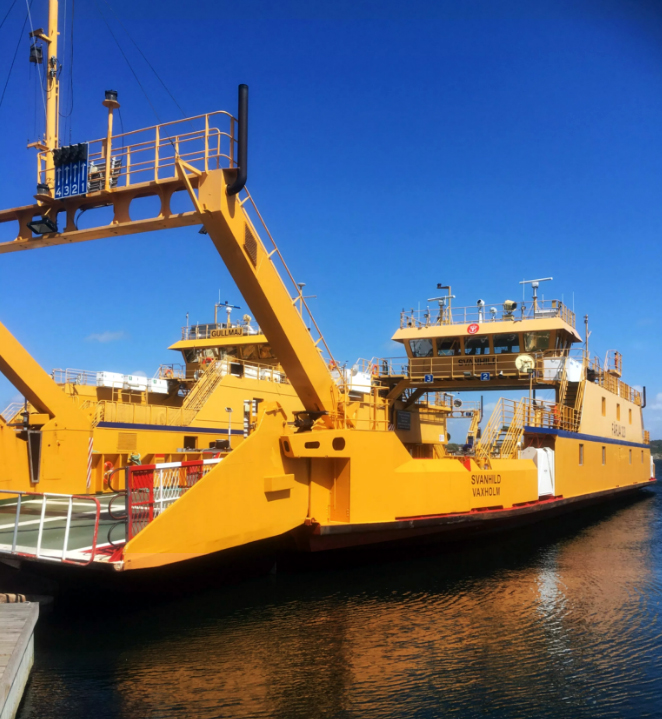With 114 journeys every day, the Svanhild ferry has a heavy workload in transporting passengers and cars between two Swedish islands. The roll-on roll-off (Ro-Ro) vessel makes 57 return trips between the islands of Lilla Varholmen and Bjorko, west of Gothenburg. Each journey on the 900m route takes around five minutes, but with such a busy schedule, time is of the essence. Yet efficiency is not the only mark of the ferry’s success; as the company is a division of the government’s Swedish Transport Administration, sustainability is also valued. As such, Trafikverket Färjerederiet has been field-testing Volvo Penta’s IMO Tier III engine package, to see whether a reduction in NOx emissions is compatible with the required performance.
In addition to reducing NOX emissions, Volvo Penta’s IMO Tier III solution also provides optimized sulphur fuel up to 1000 ppm, and ability to use either 32% or 40% urea, while the Selectie Catalytic Reduction (SCR) also acts as a silencer to reduce noise by up to 35 dBA. “We chose to test Volvo Penta’s IMO Tier III solution because our vision is to operate a service that is as environmentally-friendly as possible,” says Mikael Olofsson, the Svanhild’s skipper for Trafikverket Färjerederiet. “We have been carrying out testing for a year and it has been great.”
A 24-hour per day operation. The Trafikverket Färjerederiet operates a number of routes throughout Sweden. The 213ft (65m) Svanhild ferry – on the ‘Bjorkoleden’ route – runs 24 hours per day, making journeys every 10-20 minutes during peak hours, for commuters and sightseers. It has a capacity of 40 cars and 197 passengers. With an engine room at each end of the vessel, the ferry is able to travel easily between the two ports without having to turn around. It previously used four engines – two in each engine room – and was equipped with Volvo Penta’s 12-liter TAMD 122A models providing 203kW at 1800 rpm. The Svanhild ferry now uses only one 13-liter unit in each engine room, and is installed with Volvo Penta’s D13MH models that provide 441kW at 1900 rpm. The Volvo Penta D13MH engines in the ferry use a 360-degree gearbox and are also both equipped with an SCR unit to reduce emissions for forthcoming IMO Tier III regulations. “It is good for us to require less maintenance with fewer engines, and reduced fuel consumption and minimal exhaust emissions,” says Olofsson. He adds, “The co-operation we’ve had with Volvo Penta is very good, so we are very happy so far.”
Maximizing emissions reduction. The Volvo Penta D13MH model is an in-line 6-cylinder diesel engine that uses a high-pressure unit injector system, overhead camshaft, a twin-entry turbo with a water-cooled exhaust manifold, and miller valve timing. This contributes to world-class fuel efficiency and excellent operating economy, combined with very low emissions. As IMO Tier III regulations in the North and Baltic seas will come into force in 2021, requiring a reduction in NOx emissions by around 70%, Volvo Penta’s engine solution uses an SCR unit with 2 alternative exhaust outlets and a separate UREA injector pipe for flexible and compact installation. The engine package surpasses regulations by reducing emissions up to 75%. Additional benefits of Volvo Penta’s IMO Tier III solution: (1) Optimized for sulfur fuel up to 1000 ppm; (2) Ability to use either 32% or 40% urea; (3) SCR acts a silencer to reduce noise up to 35 dBA; (4) 6-inch robust bolt flanges; and (5) Twin 6-inch outlets.
Aniko Holm, Manager for marine field tests at Volvo Penta added: “In using more powerful engines than previously on the Svanhild ferry, Trafikverket Färjerederiet has made a great choice with our D13MH models. These two 13-litre engines give them all the power they need to run the ferry smoothly and efficiently, but with half the requirements for servicing and maintenance. And in using our IMO Tier III package, the ferry company is maximizing the reduction of emissions, well ahead of 2021 deadline.”
